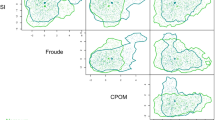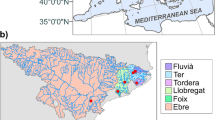Abstract
The ‘hyporheic refuge hypothesis’ predicts that the hyporheic zone, the saturated sediments below and alongside rivers and streams, is a refuge from the scouring effects of spates for many aquatic invertebrates including water mites. We tested this hypothesis in two lateral gravel bars and two riffles in a subtropical Australian river by collecting water mites from the hyporheic zone at two depths (10 and 50 cm) at two‘pre-flood’ sampling times before experimentally diverting water through the sites for 14 h to simulate a spate. Taxon richness of mites washigh (46 taxa) and dominated by the Prostigmata, with nearly half the species being new to science. Oribatids were also common at the four sites. Samples were collected twice during each ‘spate’, and again soon after flow was returned to normal. The experimental spate induced changes in the strength and even direction of subsurface-surface water exchange; however, these changes seldom persisted after the experiment, nor after a subsequent natural spate. The hyporheic refuge hypothesis was not supported by our water mite data. Neither during nor shortly after the experimental spates did we find more epigean (surface-dwelling) water mites in downwelling zones where surface streamwater enters the hyporheic zone, demonstrating that these mites were not using the hyporheic zone as a refuge at these locations. There was also no evidence for a ‘wash out’ effect, because hyporheic mitedensities did not significantly decline late in the spate. Our data indicate that floods of the low magnitude simulated in this study apparently do not pose a lasting disturbance for hypogean water mites. The fact that the same response was found at four sites indicates that the hyporheic refuge hypothesis may not always be an appropriate explanation for rapid post-flood recolonisation. Possibly, the use of the hyporheic zone as a refuge from floods may be dictated by the strength of the disturbance and substrate composition and stability.
Similar content being viewed by others
References
Analytical Software 2000. Statistix 7 User 's Manual. Analytical Software, Tallahassee,FL.
Boulton A. J. 1993. Stream ecology and surface-hyporheic hydrologic exchange:implications, techniques and limitations. Aust. J. Mar. Freshwat. Res. 44:553–564.
Boulton A. J. 2000. The functional role of the hyporheos. Verh. Int. Verein. Limnol. 27:51–63.
Boulton A. J. and Foster J. G. 1998. E. ects of buried leaf litter and vertical hydrologic exchange on hyporheic water chemistry and fauna in a gravel-bed river in northern New South Wales, Australia. Freshwat. Biol. 40:229–243.
Boulton A. J. and Harvey M. S. 2003. E. ects of a simulated spate on water mites in the hyporheic zone of an Australian subtropical river. In:Smith I. M. (ed. ),An Acarological Tribute to David R. Cook (From Yankee Springs to Wheeny Creek). Indira Publishing House, Canada,pp. 57–73.
Boulton A. J., Dole-Olivier M.-J. and Marmonier P. 2003. Optimizing a sampling strategy for assessing hyporheic invertebrate biodiversity using the Bou-Rouch method:Within-site replication and sample volume. Arch. Hydrobiol. 156:431–456.
Boulton A. J., Valett H. M. and Fisher S. G. 1992. Spatial distribution and taxonomic composition of the hyporheos of several Sonoran Desert streams. Arch. Hydrobiol. 125:37–61.
Brunke M. and Gonser T. 1997. The ecological signi cance of exchange processes between rivers and groundwater. Freshwat. Biol. 37:1–33.
Claret C., Marmonier P., Dole-Olivier M.-J., Creuzédes Châtelliers M., Boulton A. J. and Castella E. 1999. A functional classi cation of interstitial invertebrates:supplementing measures of biodiversity using species traits and habitat a. nities. Arch. Hydrobiol. 145:385–403.
Cook D. R. 1986. Water mites from Australia. Mem. Am. Ent. Inst. 40:1–568.
Di Sabatino A., Gerecke R. and Martin P. 2000. The biology and ecology of lotic water mites (Hydrachnidia). Freshwat. Biol. 44:47–62.
Dole-Olivier M.-J. and Marmonier P. 1992. Patch distribution of interstitial communities:prevailing factors. Freshwat. Biol. 27:177–191.
Dole-Olivier M.-J., Marmonier P. and Beffy J.-L. 1997. Response of invertebrates to lotic disturbance:is the hyporheic zone a patchy refugium?Freshwat. Biol. 37:257–276.
Gerecke R. and Di Sabatino A. 1996. Water mites (Acari:Hydrachnellae)and spring typology in Sicily. Crunoecia 5:35–41.
Glover B. J. and Johnson P. 1974. Variations in the natural chemical concentration of river water during. ood. ows and the lag e. ect. J. Hydrol. 22:303–316.
Gordon N. D., McMahon T. A. and Finlayson B. L. 1992. Stream Hydrology:An Introduction for Ecologists. John Wiley and Sons, Chichester.
Harvey M. S. 1990. Pezidae,a new freshwater mite family from Australia (Acarina:Halacaroidea). Invert. Taxon. 3:771–781.
Harvey M. S. 1998a. Unusual new water mites (Acari:Hydracarina from Australia,Part 1. Rec. West. Aust. Mus. 19:91–106.
Harvey M. S. 1998b. The Australian Water Mites:A Guide to the Families and Genera. CSIRO Publishing, Melbourne.
Harvey M. S. 2003. Davecookia, a new genus of the water mite family Athienemanniidae (Acarina: Hydracarina)from Australia. In:Smith I. M. (ed. ),An Acarological Tribute to David R. Cook (From Yankee Springs to Wheeny Creek). Indira Publishing House, Canada,pp. 151–153.
Lake P. S. 2000. Disturbance,patchiness,and diversity in streams. J. N. Am. Benthol. Soc. 19:573–592.
Marmonier P. and Creuzédes Châtelliers M. 1991. E. ects of spates on interstitial assemblages of the upper Rhône River. Importance of spatial heterogeneity. Hydrobiologia 210:243–251.
Palmer M. A., Bely A. E. and Berg K. E. 1992. Response of invertebrates to lotic disturbance:a test of the hyporheic refuge hypothesis. Oecologia 89:182–194.
Richards C. and Bacon K. L. 1994. In. uence of ne sediment on macroinvertebrate colonization of surface and hyporheic stream substrates. Great Basin Nat. 54:106–113.
Schwoerbel J. 1959. Ökologishe und tiergeographische Untersuchungen uöber die Milben (Acari, Hydrachnellae)der Quellen und Bäche des suödlichen Schwarzwaldes und seiner Randgebeite. Arch. Hydrobiol. Suppl. 24:385–546.
Schwoerbel J. 1967. Das hyporheische interstitial als grenzbiotop zwischen oberirdischem und subterranem Ökosystem und seine bedeutung fuör die primärevolution von kleinsthöhlenbewohnern. Arch. Hydrobiol. Suppl. 33:1–62.
Smit H. 1998. A new genus of the water mite family Piersigiidae from Australia (Acari:Hydrachnidia). Rec. West. Aust. Mus. 19:107–110.
Smith I. M. 1991. Water mites (Acari:Parasitengona:Hydrachnidia)of spring habitats in Canada. Mem. Entomol. Soc. Canada 155:141–167.
Triska F., Kennedy V. C., Avanzino R. J., Zellweger G. W. and Bencala K. E. 1989. Retention and transport of nutrients in a third-order stream in northwestern California:hyporheic processes. Ecology 70:1893–1905.
Williams D. D. 1984. The hyporheic zone as a habitat for aquatic insects and associated arthropods. In:Resh V. H. and Rosenberg D. M. (eds),The Ecology of Aquatic Insects. Praeger Publishers, New York,pp. 430–455.
Williams D. D. and Hynes H. B. N. 1974. The occurrence of benthos deep in the substratum of a stream. Freshwat. Biol. 4:233–256.
Author information
Authors and Affiliations
Rights and permissions
About this article
Cite this article
Boulton, A., Harvey, M. & Proctor, H. Of spates and species: responses by interstitial water mites to simulated spates in a subtropical Australian river. Exp Appl Acarol 34, 149–169 (2002). https://doi.org/10.1023/B:APPA.0000044445.30246.b2
Issue Date:
DOI: https://doi.org/10.1023/B:APPA.0000044445.30246.b2




